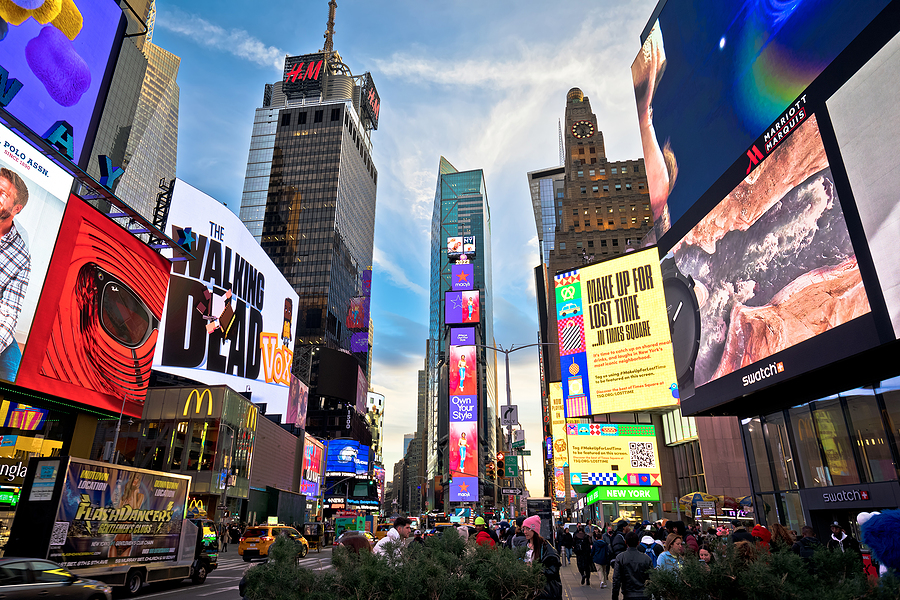Times Square in New York City is a bustling crossroads of commerce and culture. The first image that will spring to mind for many people is of course the dominant presence of the giant LED advertising screens. Here’s a look at how this icon of groundbreaking marketing evolved, and the lessons that UK businesses can learn from it.
The early years
Back at the start of the 18th century, the site of Times Square was once a humble farmstead. As the city rapidly evolved, it was simply a large crossroads surrounded by apartment buildings. According to the Museum of the City of New York, the area was originally named Long Acre after the carriage district of London and served as a horse exchange.
The arrival of electricity in the early 19th century sowed the seeds of transformation, making it a brighter and safer place to live and work. This attracted new businesses to the area, and the construction of the city’s first transit system improved the accessibility.
The New York Times Building
In 1904, the New York Times constructed One Times Square as their headquarters, and the area was renamed Times Square. This ensured that it would soon become a hub of connectivity and a magnet for trade. To celebrate their launch, the newspaper put on a lavish fireworks display on New Year’s Eve.
This evolved into the spectacular lowering of the Waterford crystal ball, setting the tone for the cutting edge marketing techniques to follow. Today, the ball is powered by LED technology and is lit to celebrate other calendar events such as Valentine’s Day and Halloween, drawing crowds of hundreds of thousands.
The New York Times moved on to a larger venue after ten years, but the ball had well and truly been set rolling, and the Square became a hub of nightlife with theatres, bars, and restaurants. It was a honeypot for residents and tourists alike, fuelled by ease of access from the subway and overhead lines. The New Year’s Eve celebrations remain to this day.
A Hotbed of Advertising
The vibrant commerce and culture of Times Square naturally lent itself to advertising. Soon giant static billboards appeared, and in fact the first electrified adverts appeared in 1904. They carried adverts for Budweiser and Trimble Whiskey among others. By the 1940s, advertisements for everything from cigarettes to motor vehicles proliferated.
In the economic boom that followed World War II, the advertising screens grew ever larger and more numerous. Companies began to compete for converted marketing space on the side of the towering buildings, paying hundreds of thousands of dollars for a prime position. By the 1990s, the electronic screens were replaced with digital LED screens.
What can we learn from the marketing triumph of Times Square?
Times Square has always been ready to embrace technological innovation, from the first electronic billboard way back in 1904, to the cutting edge LED screens of today. Furthermore, it’s a thoroughly cosmopolitan area that has always been ready to adapt to cultural shifts and remain relevant to consumers’ needs and preferences.
The technology now exists to make not just passive advertising images and messages, but to create immersive and interactive experiences that truly command the attention. For example, many of the screens now use dazzling 3D or even virtual reality displays that are captivating and groundbreaking.
Advertising strategies are now highly targeted, and the screens can be programmed to react to audience profiles, times of day, or even the weather. This means that consumers are always seeing the most relevant messages and businesses are maximising their return on investment.
Of course, Times Square is in an unbeatable position for the size and diversity of its audience, meaning that the adverts will be seen by millions of people every day. Not every location will be able to replicate this kind of scale, but it does underline the importance of choosing the site of your LED screen for maximum impact.
The giant billboards of Times Square not only impart marketing messages, but they are also used to livestream entertainment events, news feeds, and social media content. This helps brands go beyond merely advertising, to create an authentic connection with their audience, and ensure they are memorable and engaging.

